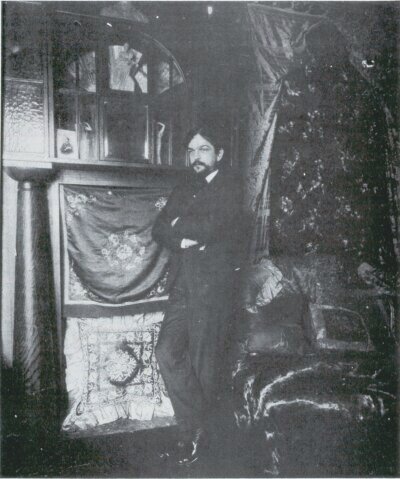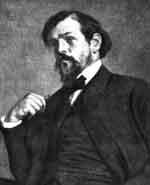
Debussy in Jersey by Diane Enget Moore - Page 2
Home Page Introduction Debussy in Jersey The Blüthner Music Links
Debussy's Life - a brief synopsis
Early Years Breakthrough Mature Debussy
Achille-Claude Debussy was born in St. Germain-en-Laye, a Paris suburb, in 1862. As a child he had little formal education but his musical tendencies were channelled into lessons, those with Verlaine's mother-in-law, Mme Mauté de Fleurville, leading to his entry into the Paris Conservatoire in 1872. His reputation there was that of an erratic pianist.
In 1880 and 1881 he went for summer employment to Russia as pianist to Tchaikovsky's patron, Mme von Meck. Failing to win the Prix de Rome in 1883, he succeeded in 1884 with the cantata L'Enfant prodigue. He spent 2 years at the Villa Medici, Rome, where he met Liszt, Verdi, and Boito, and heard Lohengrin.

(Debussy photographed by Pierre Louÿs, 4th May 1894.
© Photo: Bibliothèque François-Lang, abbaye de Royaumont)
Back in Paris, living a very bohemian lifestyle in Montmartre, he met Gabrielle Dupont who became his lover for 10 years. He called her “Gaby aux yeux verts”, Gaby with the green eyes. It was during this period that he started to go to les mardis, the Tuesday group of mainly Symbolist writers who would gather at Mallarmé's apartment in the Rue de Rome. He met amongst others, Paul Verlaine. He also became close friends with Pierre Louÿs at this time. Their poetry was to inspire Debussy to write numerous pieces. The declaration that art should allow intuition to reign over the intellect, was of great interest to Debussy. Mallarmé said that the Symbolists’ method was to "d'évoquer, dans une ombre délibérée, un objet non mentionné en utilisant des mots allusifs". In other words to throw a deliberate veil over unidentified elements, yet evoke their presence through allusive words…
Verlaine, in his Art Poetique, said "De la musique avant toute chose" ("Music above all else"). Baudelaire’s much earlier explorations of the dark undercurrents of human existence in Les fleurs du mal (1857) were a fascination for the Symbolists, and the famous words from the poem Correspondances might summarise this attraction: “Les parfums, les couleurs et les sons se répondent”. ("Scents, colours and sounds answer one another"). This alludes to the state of mind known as synaesthesia, the fusion of all the senses into one melodious expression. Baudelaire came back to this image in the first stanza of another poem, Harmonie du Soir: “les sons et les parfums tournent dans l’air du soir” ("Sounds and scents turn on the evening air"), and this famous line was to become the title of one of Debussy’s most mystical pieces.
One by one, inspirations came to Debussy. First the Symbolists, then the Impressionists. Monet, Renoir amongst others, attempted to paint light in all its subtleties. Light on water, light on rocks, trees and landscapes and buildings. The changing light and what can be alluded through it.
Debussy’s relationship with Wagner’s music was one of "denial", one from which he could never free himself, nor did he (deep down) ever wish to. He had been to the Bayreuth festivals of 1888 and 1889 where he heard Die Meistersinger, Tristan und Isolde and Parsifal. He once called him "ce vieil empoisonneur" ("that old poisoner"), but nevertheless, when one listens to Debussy’s music, especially the orchestral pieces, one can almost hear Wagner’s voice in the wings. I’m thinking particularly of Pelléas et Melisande, the opera based on Maurice Maeterlinck’s play which was premiered in 1902.
Other influences I would mention are the Javanese Gamelan, which impressed Debussy at the Exposition Universelle de Paris in 1889, and his love of Japanese art (owning a large collection of Japanese vases and prints).
Important firendships and influences include Pierre Louÿs (1870-1925) a number of whose Chansons de Bilitis Debussy put to music, and of course Erik Satie (1866-1925). Debussy later orchestrated two of Satie’s Gymnopédies.
The breakthrough works for Debussy were clearly between 1887 and 1889 when he wrote Cinq poèmes de Baudelaire and Ariettes oubliées based on Verlaine’s poetry. In 1890 he wrote his famous Clair de Lune, which he revised in 1905, a year after the Jersey stay (and I’ll come back to that as I feel it is of importance). His genial “tour de force” came in 1894, an orchestral poem based on Stephane Mallarmé’s poem Prélude à l'après-midi d'un faune, which was to transform western music.
Debussy's opera Pelléas et Mélisande was produced in 1902. It earned Debussy widespread fame, his score enhanced the abstract, dreamlike quality of Maeterlinck's play and his treatment of the melody almost duplicates the rhythm of natural speech. Many critics have regarded Pelléas et Mélisande as a perfect fusion of music and drama, and his opera has had numerous revivals.
 (Portrait by
Jacques-Emile Blanche, 1902. Source: Library of Congress, Prints and Photographs
Division, George Grantham Bain Collection.)
(Portrait by
Jacques-Emile Blanche, 1902. Source: Library of Congress, Prints and Photographs
Division, George Grantham Bain Collection.)
From 1902 to 1910 Debussy wrote chiefly for the piano, rejecting the traditional
percussive approach to the instrument and emphasizing instead its capabilities
for delicate expressiveness. His most important works of this period include
Estampes (1903), Masques (1904), L'Isle joyeuse (1904),
Images (I, 1905 and II, 1907), Children's Corner
(1906-1908), Préludes Livre I (1909-1910), Préludes Livre II
(1910-1912). His major orchestral piece from this period is La Mer
written between 1903 and 1905 (in Jersey, Dinard and Eastbourne).
Whilst his public life became increasingly successful, his private life was riddled with scandal. Gaby "with the green eyes" had threatened suicide when their relationship came to an end. In 1899, Debussy married Rosalie Texier, a dressmaker. He left her in 1904 for Emma Bardac, an amateur singer and the wife of a Parisian banker. He moved into an apartment with Emma in the Avenue du Bois de Boulogne, where he spent the rest of his life. Debussy married Emma in 1908, following the birth in 1905 of his one daughter, Claude-Emma, the "Chou-chou" to whom the Children's Corner (1906-1908) was dedicated.
Mature Debussy
In 1909 Debussy learned that he was afflicted with cancer. Most of his late
works are chamber music, including three extraordinary sonatas, for cello; for
violin; and for flute, viola, and harp. His energies increasingly sapped by the
ravages of cancer, Debussy worked on with remarkable fortitude. The outbreak of
the First World War in 1914 robbed him of all interest in music. France, he
felt, "can neither laugh nor weep while so many of our men heroically face death." After a year of silence, he realized that he had to contribute to the struggle
in the only way he could, "by creating to the best of my ability a little of
that beauty which the enemy is attacking with such fury." One of his last
letters speaks of his "life of waiting--my waiting-room existence, I might call
it--for I am a poor traveller waiting for a train that will never come any
more." His last work, the Fourth Sonata for Violin and Piano, was performed in
May 1917 with Debussy at the piano. It was the last music that he played in
public, at St. Jean-de-Luz in September.
Debussy died in March 1918 during the bombardment of Paris by airships and
long-distance guns during the last German offensive of World War I.